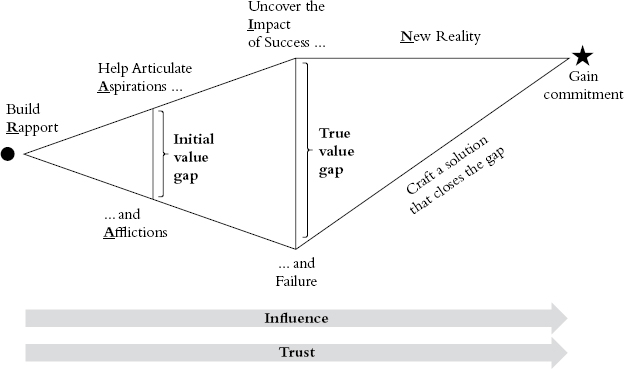Appendix
RAIN Selling
RAIN stands for:
- Rapport
- Aspirations and Afflictions
- Impact
- New Reality
Also, the A and the I perform double duty as a reminder to balance Advocacy and Inquiry, and the IN will help you remember to maximize your influence.
Following is an overview of the major components of RAIN (Figure A.1).

Figure A.1 RAIN SellingSM
Rapport
As noted in Chapter 4, although rapport and personal connections don’t represent the totality of strong business relationships, these elements remain vitally important.
Building rapport is sometimes dismissed as a ploy to make a superficial connection with a potential buyer. We agree—you shouldn’t make superficial connections; you should make genuine connections. Genuine rapport sets the table for the rest of the conversation and creates the foundation for trust. A genuine connection with a buyer is so important in selling because, all things being equal, buyers buy from—and trust—people they like. Rapport is not enough to win, but without it, sellers don’t get very far.
Aspirations and Afflictions
Many sales methodologies suggest that to sell products and services as solutions to needs, you must first uncover the buyer’s problem or pain. However, all too often, these words drive sellers to employ find-out-what’s-wrong-and-fix-it thinking. Let’s say the buyer doesn’t perceive anything to be wrong. Soothe-the-pain sellers find themselves at a dead end. No problems to fix means nothing to sell.
The sellers most successful at applying insight focus as much on the positives—the goals, aspirations, and possibilities achievable by the buyer—as they do on the negatives. Sellers who focus on aspirations as well as afflictions are able to directly influence the buyers’ agenda—and drive their own demand—by inspiring buyers with possibilities they hadn’t been considering but should be.
Impact
After a seller uncovers a prospect’s aspirations and afflictions, the question becomes, “So what?” If your afflictions aren’t solved, so what? What won’t happen? Will the afflictions get worse? How will they affect the bottom line of your company, division, or department? How will they affect your life?
If your aspirations don’t become reality, so what? Will your competition get ahead of you if you don’t innovate? Will you lose market share if you aren’t aggressive in your strategy? Will you never be able to grow your business to a point where you can sell it and reach your personal financial goals? Will the promotion you desire continue to elude you?
The exact so what questions will vary depending on the situation, but your ability to quantify and paint the so what picture creates the foundation for how important it is for the decision maker to buy from you. The more impact, the more urgency to buy.
New Reality
One of the greatest difficulties in sales is helping buyers understand exactly what they get when they work with you. To accomplish this, you need to do three things:
- Establish the possible new reality early. Early in sales processes, sellers must inspire buyers with what’s possible. What’s the new reality they could achieve if they so desired? At the end of the sales process, sellers need buyers to see that where they are now specifically is not good enough, because there’s a much better place (new reality) they can be. They may already have an idea of what that is, or you may show them what’s possible. In any case, they need a finish line in their sights, or they’ll never get out of the gate.
- Quantify the impact. Will they save 22 percent or $1.2 million on costs of widgets? Improve their cycle times by 13 days? Improve quality levels by 17 percent? Quantifying the new reality makes buyers pay attention and gives them justification (for themselves and for others) for moving forward.
- Paint the before and after pictures. If a picture is worth a thousand words, then a chart, a graph, or a table that juxtaposes the current state and the new reality is worth even more. The goal is to paint a compelling picture. Doing so will show that it’s in the buyer’s interest to take action and that you are the best choice to help.
Advocacy and Inquiry
The A and the I also help us remember to balance advocacy and inquiry.
Many inexperienced sellers believe their job is to show and tell. And tell. And tell. Incessant pitching and presenting feels to buyers like they’re being sold at. If you’re doing all the talking, they’ll feel like you are self-centered, don’t care about them, and don’t understand their situations and needs (even if you do). Worst of all, savvy buyers will peg you as an amateur and dismiss you. People like to talk about themselves and tell their own stories—make sure you give your buyers this opportunity.
Salespeople often hear, at some point in their careers, “The sellers who succeed the most always ask great questions.” This is true to a point; asking incisive questions is critical to sales success, but some sellers take the advice too literally. If they always ask questions, they don’t share a point of view or an opinion, don’t tell stories, and don’t help set the agenda for success. Although questions are quite valuable, there’s a fine line before buyers start to feel like they’re being interrogated. And they need to know what you bring to the table. You may ask good questions, but buyers also need to know what you’re selling in terms of offerings and outcomes. The key is to balance advocacy and inquiry and to learn when to use one or the other.
Influence
The IN in RAIN is a reminder to apply influence in your sales conversations. Master the principles of influence1 and you’ll become more effective in each stage of your sales conversations.